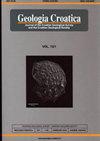斯洛文尼亚Krško-Brežice油田砂的液化潜力
IF 1.1
4区 地球科学
Q3 GEOLOGY
引用次数: 2
摘要
Krsko-Brežice油田是斯洛文尼亚地震最活跃的地区之一。有记录以来破坏性最大的地震发生在1917年1月29日,强度为8级(EMS)。它造成了损失,并夺去了两人的生命。在过去的100年里,有9次烈度高于VI (EMS)的地震被记录下来。研究区表层厚达5 m,由新近沉积的非常松散的粉砂和砂(ML、SM、SP)组成,覆盖着中致密至致密的第四纪砾石,其下为过度固结的中新世未胶结的粉砂和泥灰岩。据报道,最上层可能容易液化,在Brežice附近的地方,在1880年萨格勒布地震和1909年库帕谷地震期间观察到液化现象。本文介绍了通过室内指标试验、循环单剪试验和现场调查(SPT、CPT、(S)DMT、vs测量)对Brežice水电站(HPP)顶板液化潜力进行评价的结果。所有结果表明,对于一个475年的重复周期的地震,上层容易液化。循环单剪试验结果表明,在475年复发周期的地震中,将水平地面的顶层致密化至最大普罗克特密度的95%以上,可使水平地面的液化潜力降低。本文章由计算机程序翻译,如有差异,请以英文原文为准。
Liquefaction potential of sands at the Krško-Brežice field, Slovenia
The Krsko-Brežice field is one of the most seismically active areas in Slovenia. The most damaging recorded earthquake with an intensity of VIII (EMS) occurred on 29th January 1917. It caused damage and claimed two lives. In the last 100 years, 9 earthquakes with intensity higher than VI (EMS) have been recorded.
At the investigated area, a top layer up to 5 m thick, consisting of recent deposit of very loose silts and sands (ML, SM, SP), covers the medium dense to dense Quaternary gravel, beneath which there are over-consolidated, uncemented Miocene silts and marls. The top layer could be prone to liquefaction, as reported for the close surroundings of Brežice, where the liquefaction phenomenon was observed during the Zagreb earthquake in 1880 and during the Kupa Valley earthquake in 1909.
The paper presents the results of laboratory index tests, cyclic simple shear tests and field investigations (SPT, CPT, (S)DMT, vs measurements), which were carried out to assess the liquefaction potential of the top layer at the location of the Brežice Hydroelectric Power Plant (HPP). All results show that the top layer is prone to liquefaction for an earthquake with a 475 year return period. Cyclic simple shear test results show that the liquefaction potential of horizontal ground for an earthquake with a 475 year return period can be reduced by the densification of the top layer to at least 95% of maximum Proctor density.
求助全文
通过发布文献求助,成功后即可免费获取论文全文。
去求助
来源期刊

Geologia Croatica
GEOSCIENCES, MULTIDISCIPLINARY-
CiteScore
2.90
自引率
23.10%
发文量
35
审稿时长
>12 weeks
期刊介绍:
Geologia Croatica welcomes original scientific papers dealing with diverse aspects of geology and geological engineering, the history of the Earth, and the physical changes that the Earth has undergone or it is undergoing. The Journal covers a wide spectrum of geology disciplines (palaeontology, stratigraphy, mineralogy, sedimentology, petrology, geochemistry, structural geology, karstology, hydrogeology and engineering geology) including pedogenesis, petroleum geology and environmental geology.
Papers especially concerning the Pannonian Basin, Dinarides, the Adriatic/Mediterranean region, as well as notes and reviews interesting to a wider audience (e.g. review papers, book reviews, and notes) are welcome.
 求助内容:
求助内容: 应助结果提醒方式:
应助结果提醒方式:


